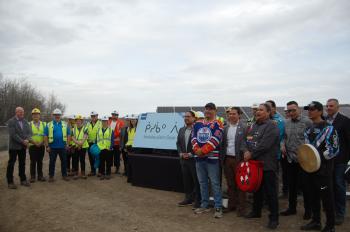Image Caption
Summary
Local Journalism Initiative Reporter
Windspeaker.com
On May 4, the Enoch Cree Nation and EPCOR unveiled the new name of EPCOR’s solar farm: kīsikāw pīsim means “day sun”. In Cree syllabics the name is ᑮᓯᑳᐤ ᐲᓯᒼ .
Kīsikāw pīsim is located in the Edmonton city ward of Sipiwiyiniwak (meaning “River Cree”) just off of the Anthony Henday Drive intersection of Maskêkosihk Trail North (meaning “people of the land of medicine”).
The name for the solar farm was presented to EPCOR in January through a pipe ceremony and prayer.
Speaking before the unveiling of the sign marking the location, Enoch Cree Nation Chief Billy Morin said “tough conversations” were held following EPCOR’s initial announcement proposing the solar farm in 2017 to the time when the nation and EPCOR signed a memorandum of understanding in September 2020.
Initially, said Morin, Enoch was opposed to the development of the solar farm to be situated in southwest Edmonton on land that was stolen from the nation by the federal government in 1908. It’s the same land that has held the E.L. Smith water treatment plant since 1976.
“Reconciliation is most effective when it promotes a space for tough conversations to be had. That tough conversation was had and look what it … bore fruit in,” said Morin.
He also credited EPCOR for bringing the Enoch Cree Nation to the table, which “opens up other doors” when it comes to the nation being involved in more green energy development.
EPCOR’s president and CEO Stuart Lee referred to the project on the land as an “intersection” of the past and the future.
“Today, we're here to celebrate the intersection of innovation… solar panels harnessing the sun and the intersection with history and the people who walked on this land for thousands of years. So we celebrate the path forward and we look at the path behind us,” said Lee.
Lee also pointed out that the water treatment plant, which services more than 60 communities, counts among those the Enoch Cree Nation, Alexis Nakota Sioux Nation, Whitefish First Nation and Paul Band.
Lee said through the solar farm “clean energy will be used to produce clean water.”
Among the reasons for kīsikāw pīsim to be located at this particular site was the ability to supply power directly to the water treatment plant instead of having to go through the electrical grid. Solar energy will eventually account for 50 per cent of the power needed to operate the water treatment plant and its distribution processes, generating 21,500 megawatt hours of renewable energy annually.
Solar energy will make the plant more self-sufficient and resilient, said Lee.
The final solar panel for kīsikāw pīsim was installed on March 8. There are 30,350 panels on a 51-acre footprint.
Lee said supply chain challenges had delayed the start of the farm’s operation by a couple of months as they are still waiting for a battery and other equipment.
The projected start of operation for kīsikāw pīsim is the end of September or the beginning of October, said Lee.
Kīsikāw pīsim will allow EPCOR to reduce its greenhouse gas emissions in Edmonton by 20 per cent and help contribute to reaching the City of Edmonton's goal of producing 10 per cent of electricity locally with green energy.
Local Journalism Initiative Reporters are supported by a financial contribution made by the Government of Canada.

